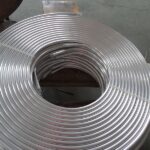Fin Tube Evaporator Coil
Fin Tube Evaporator coil is a heat exchanger used in air conditioning and refrigeration systems. It consists of copper or aluminum tubes with aluminum fins attached to them. These coils facilitate the transfer of heat from the refrigerant flowing inside the tubes to the air passing over the fins. This process allows the refrigerant to evaporate, absorbing heat from the air, and thereby cooling the air inside the conditioned space. Fin tube evaporator coils are essential components in HVAC systems, providing efficient cooling while maximizing surface area for heat transfer.

Fin Tube Evaporator Coils in HVAC and Refrigeration Systems
Uses of
- Heat Exchange: Facilitates the transfer of heat between the refrigerant flowing inside the tubes and the air passing over the fins.
- Cooling: Absorbs heat from the air inside a conditioned space, thereby cooling it down.
- Dehumidification: Helps to reduce humidity levels by cooling the air, causing moisture to condense and collect as water.
- Air Quality Improvement: Enhances indoor air quality by removing heat and humidity, creating a more comfortable environment.
- Temperature Control: Regulates the temperature within HVAC systems to maintain desired comfort levels.
- Refrigeration: Supports the cooling process in refrigeration systems for preserving food, beverages, and other perishable items.
Fin Tube Evaporator Coils
Material Options and Characteristics for
| Component/Part | Material Options | Characteristics |
|---|---|---|
| Tubes | Copper, Aluminum, Stainless Steel, Carbon Steel, Titanium, Brass | – Copper: High thermal conductivity, ductile. – Aluminum: Lightweight, cost-effective, good thermal conductivity. – Stainless Steel: Corrosion-resistant, durable. – Carbon Steel: Strong, cost-effective. – Titanium: Exceptional corrosion resistance. – Brass: Balance of thermal conductivity and corrosion resistance. |
| Fins | Aluminum, Copper, Stainless Steel | – Aluminum: Lightweight, cost-effective. – Copper: High thermal conductivity. – Stainless Steel: Corrosion-resistant, durable. |
| Headers | Copper, Brass, Stainless Steel | – Copper: High thermal conductivity. – Brass: Corrosion-resistant, machinable. – Stainless Steel: Corrosion-resistant, durable. |
| Manifolds | Aluminum, Stainless Steel | – Aluminum: Lightweight, cost-effective. – Stainless Steel: Corrosion-resistant, durable. |
| Frame/Casing | Galvanized Steel, Stainless Steel | – Galvanized Steel: Economical, provides protection against corrosion. – Stainless Steel: Corrosion-resistant, durable. |
| Coil Coating | Epoxy, Polyester, Phenolic | – Epoxy: Provides good corrosion resistance. – Polyester: Offers durability and color options. – Phenolic: Excellent chemical resistance. |
Fin Tube Evaporator Coils
Benefits of
- Efficient Heat Transfer: Enhanced surface area from fins increases heat transfer efficiency, crucial for effective cooling or heating in HVAC systems.
- Compact Design: Allows for high heat transfer in a relatively small space, making them suitable for use in compact air conditioning units and refrigeration systems.
- Versatility in Material: Can be constructed from various materials like copper, aluminum, and stainless steel, offering flexibility to suit different environmental and operational needs.
- Corrosion Resistance: Materials like stainless steel and coated aluminum fins provide durability and resistance to corrosion, extending the lifespan of the coil.
- Cost-Effectiveness: Depending on the material choice and design, fin tube evaporator coils can offer a cost-effective solution for heat exchange needs in HVAC and refrigeration applications.
- Energy Efficiency: Optimal heat transfer capability contributes to the overall energy efficiency of HVAC systems, reducing operational costs over time.
Fin Tube Evaporator Coils
Types of
- Slab Coils
- A-Frame Coils
- L-Coils
- Coil-in-Coil
- Exposed Tube Coils
- These are flat, compact coils typically used in air handling units and packaged HVAC systems.
- Shaped like an inverted “V”, these coils are often used in rooftop HVAC units and some industrial applications.
- Shaped like an “L”, these coils are suitable for installations where space is limited, such as in small air conditioning units or refrigeration systems.
Other Finned Tube Heat Exchanger We Manufacture
Chilled Water Finned Tube Coils
Chilled Water Finned Tube Coils are components used in HVAC systems for cooling. They consist of a series of tubes with external fins that increase surface area for heat transfer.
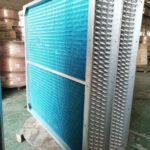
Air Handling Unit
Air Handling Unit (AHU) coil is a vital component in HVAC systems, designed to heat or cool air. It comprises tubes through which refrigerant or water circulates and fins that increase
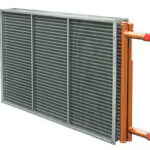
Fan Coil Unit
Fan Coil Unit (FCU) is a device used in HVAC systems to control the temperature and airflow in a space. It typically consists of a heat exchanger (coil) connected to a fan
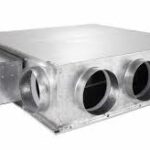
Hot Water Steam Coils
Hot Water Steam Coils are heat exchangers used in HVAC systems to transfer heat from hot water or steam to air. They consist of tubes, usually made of copper or steel,
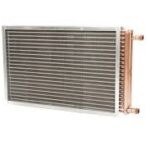
Air Cooled Heat Exchanger
Air Cooled Heat Exchangers (ACHEs) are devices that transfer heat from a fluid (liquid or gas) to the surrounding air. They use finned tubes to increase the surface area for heat transfer
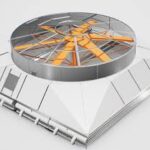
Rice Mill Heat Exchanger
Rice Mill Heat Exchanger is a device used to regulate and control the temperature during various stages of rice milling, such as drying, parboiling, and cooling.
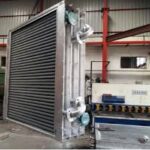
Foundry Sand Cooler
Foundry Sand Cooler is a piece of equipment used in foundries to cool hot sand after it has been used in the casting process. The cooling process is essential to prepare the sand
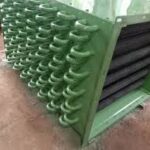
Air Blast Oil Cooler
Air Blast Oil Cooler is a heat exchanger used to cool hydraulic oil, lubricating oil, or other fluids in industrial machinery and automotive applications.
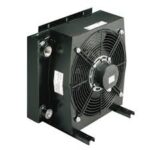
Aluminum Finned Water Tube Coils
Aluminum Finned Water Tube Coils are heat exchangers used in HVAC systems to transfer heat between air and water. They consist of tubes, typically made of copper or another material
